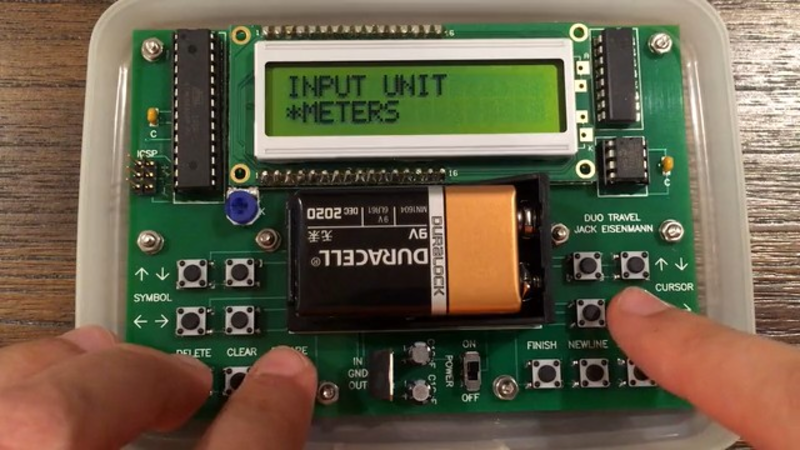If there was one downside to 8-bit computers like the Commodore 64, it’s that they weren’t exactly portable. Even ignoring their physical size, the power requirements would likely have required a prohibitively large power bank of some sort to lug around as well. The problem of portability has been solved since the late ’70s, but if you still want that 8-bit goodness in a more modern package you’ll have to look at something like retrocomputing madman [Jack Eisenmann]’s DUO Travel computer.
The computer is based around the ubiquitous ATmega328 which should make the ease at which it is programmable apparent. Even so, its 14-button keypad makes it programmable even without another computer. While it has slightly less memory than a standard C-64, it’s still enough for most tasks. And, since its powered by a 9-volt battery it doesn’t require any external power sources either.
The most impressive part of the build, however, is the custom programming language specifically tailored for this platform. After all, a 14-button keypad wouldn’t be a great choice if you had to program in Perl or C all the time. There is some example code on the project page for anyone interested in this specific implementation. While it’s not the most minimal computer [Jack] has ever built, it’s certain to be much more practical.

















Symbol and Cursor keys would be better in diamond formation.
I see a big engineering no-no: 9V battery and 5V regulator. That’s the worst possible choice for powering anything, especially a portable computer. I’d suggest using a small boost converter, charge circuit with protection and a Li-Ion or Li-Po battery…
+1
Why is that? Batteries have a very unstable voltage since it’s dependent on its charge. You just need an efficient switching regulator. I think buck regulators are more efficient than boost regulators, so you’d need to start with a higher voltage.
9v battery has very low capacity and high internal resistance (it is basically 6 cells connected back to back). Add here the average efficiency of LINEAR regulator, and you get ~50% power efficiency.A big no-no in a portable device.
Just for the note – the capacity is ~500mAh for the battery. Oh, and they are pricey.
Also – if you use Ni-Mh cells (4 AA cells), you would not really need a regulator – fully charged AA battery is about 1.5v, this is below absolute maximum rating for atmega, fully depleted – 0.9v – it is still workable, may be with contrast adjustment for the display.
Give the man some credit. It’s a great little project and would be good for kids to learn code. Yes it would be better if the power part was better but he made it simple so anyone can just put a 9volt battery in.
I think it’s a good little project and would be great in schools to show how code works.
I got into programming when I bought a HP41 calculator. Good keyboard, alphanumeric display… happy memories.
I appreciate the effort here, but the thought of writing anything (on those tactile pushbuttons) makes my fingers hurt.
Switch type, size, activation force, travel, layout, and even labelling can make or break a design.
http://sfrolov.livejournal.com/108594.html :) and http://sfrolov.livejournal.com/125488.html
The first one is a lot better in layout
Back in the day the Ham operators found that they could put a battery on the VIC-20 for doing things like RTTY. I don’t think they took a monitor with them, the one person that showed me his had in in a backpack like he would go to a site and set up.
What made the VIC-20 usable anywhere near a radio receiver was what made the VIC20 slower than the C64 which was that the Processor wasn’t jumping on and off the bus shared with the VIC chip with the inevitable contention at the beginning and end of each cycle.The VIC20 also didn’t have a crazy supply like in the C64 with a dependence on 9VAC as well as +5V.
Interesting bit of history there, but I’m not really sure how they’d use it without a monitor, unless they were just using it as a beacon.
I suppose for RTTY all you’d need for display purposes is an HD44780 type LCD display, which would have been portable enough, but I don’t think those were available before the mid 1980’s. Hell, a battery powered portable CRT TV would have done the job, and I think those were around in the early 80’s.
A Commodore SX-64 would have been a great choice for portable RTTY back in that era. It didn’t run off of battery power, but they had generators back then, right? Expensive and overkill, but I don’t think that form factor could have been any better for that purpose.
Anyone here ever play with a Cybiko? They were little handheld devices with a Hitachi H8 and an Atmega that handled peer-to-peer wireless communication. Also had an i/o port for expansion (or bit bangig).
Very cool little device, and extremely well engineered in some respects (in others, not so much). I wrote my first edge-connected “Internet of Things” kind of thing with one.
I think a moronic marketing strategy (“game a day”) did them in .. it kind of limited vision regarding the device’s capabilities, and probably tied up resources cranking out content in the form of games that were not especially compelling.
http://cultureandcommunication.org/deadmedia/index.php/Cybiko
I still have a few, mouldering away somewhere …
Sounds like something I need. Sometimes I just need a fix of programming. I’ve written loads of useless JavaScript stuff on my phone..
“If there was one downside to 8-bit computers like the Commodore 64,”
Blasphemy! the c64 had no downside
I had an SX64